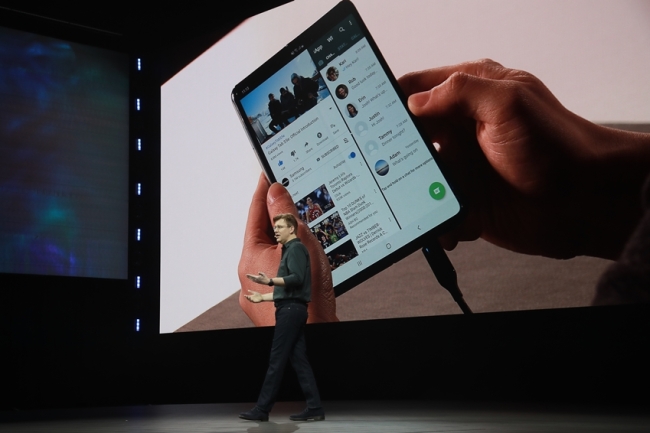Samsung
Samsung Galaxy Fold more advanced than Huawei’s Mate X: experts
Chinese tech firm Huawei has recently jumped on the foldable smartphone bandwagon, following the lead of Samsung Electronics that showcased its first such model last week.
According to some market experts, Samsung outshone the Chinese rival, at least in terms of technology, in their latest face-off.
“A display that folds inward is, say, 100 times more advanced than a display that folds outward,” said an official from a display technology company.
 |
Related:
Analysts split on whether Samsung Galaxy Fold can be a game changer
The Chinese firm’s Mate X, launched during the ongoing Mobile World Congress trade show in Barcelona, Spain, is fitted with an 8-inch external screen that wraps around the smartphone body when folded outward.
Samsung’s Galaxy Fold, on the other hand, comes fitted with two screens -- a 7.3-inch internal screen and a 4.6-inch external one. The internal screen can open and shut like a book.
The inward folding device is thought to boast a bend radius as small as 1 millimeter, which shows how much a display can bend without being damaged.
Huawei’s foldable smartphone officially measures at 11 millimeters in thickness when folded outward, meaning the display has a curvature of at least 11 millimeters to fold out.
Because of technical barriers to develop an in-folding screen, Huawei may have opted for the outward-folding design, according to the industry official.
“Since Samsung Display, a subsidiary of Samsung Electronics, is the only company that has the expertise and high yields to produce in-folding displays, no other company will be able to launch in-folding foldable devices for a while,” the official said.
BOE Technology Group and LG Display are some of the other flexible OLED panel makers for smartphones, but their yield rates are said to be far from satisfactory. BOE has reportedly supplied foldable screens for Huawei.
Mate X’s outward-folding design also leaves the device always at risk of getting scratches.
“Since colorless polyimide, a flexible film used for a foldable smartphone screen, is not as hard as a smartphone screen made of a glass panel, an outward-folding device is more exposed to scratches than in-folding ones,” a market watcher said.
Some market analysts pointed out, however, technical superiority does not always lead to success in the market as curved-screen smartphones, like Samsung’s Galaxy Round and LG Electronics G Flex, proved.
They said the success of foldable smartphones depends on whether device manufacturers can give consumers an answer to the question, “Why does a phone have to fold?”
“The fact that a phone can fold will not be able to attract consumers,” said local think tank KT Economics and Management, adding comfortable UX and UI and apps optimized for a large screen are some of the prerequisites for the wider adoption of two-in-one devices by general consumers.
Market research firm Strategy Analytics predicted that the foldable smartphone market will grow from 14 million in 2020 to 50 million by 2022.
By Kim Young-won (wone0102@heraldcorp.com)






![[From the Scene] Gigantic Olive Young store lures young trend-setters in Seongsu](http://res.heraldm.com/phpwas/restmb_idxmake.php?idx=151&simg=/content/image/2024/11/21/20241121050065_0.jpg)

